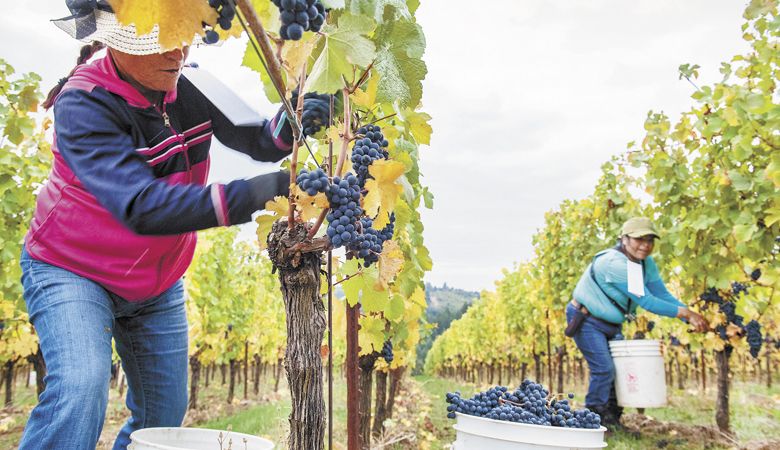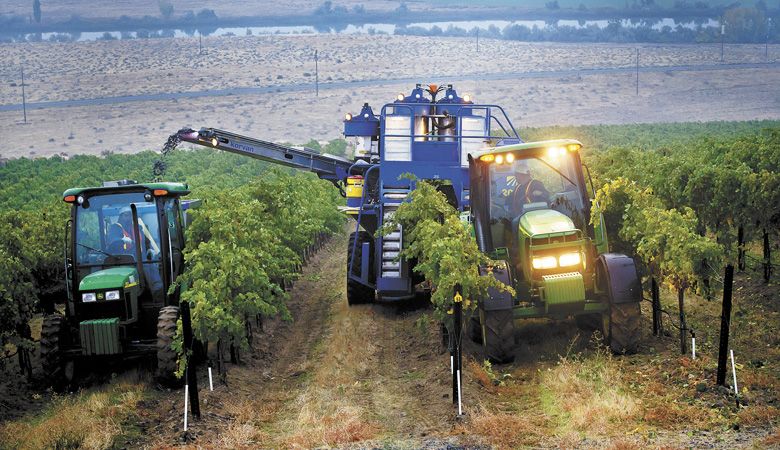Short on Labor
Scarcity of workers lays ground for challenging harvest, changing industry
Last year’s outlier wine harvest took center stage during a pandemic and starred wildfires and smoke; it had its share of labor shortage issues, too. Mitigating circumstances, such as vineyard decisions to not pick as much as 40% of fruit, lessened labor pressures.
What about this year’s harvest? What if 2021’s yield is a stellar one with fire/smoke problems minimal? Will there be enough picking hands during crucial prime harvest times? Can a large enough crew be assembled on a day or two’s notice?
The answer is unknown.
For years, Oregon’s vineyard labor pool has ebbed and flowed, but, overall, it is shrinking. One key factor is generational. Older workers are retiring and doing so at a fairly rapid pace. These individuals have been loyal to the same vineyards continuously, all the while developing knowledge of particular terrain and intricate skills need for a job well done.
During harvest, a certain natural friction exists among older and younger workers; the latter often intent on building per-bucket earnings as fast as possible. Time is money, after all, but when the job is hurried, clean picking and quality can suffer.
With access to the latest job information via smartphones, seasonal workers instantly can identify where to land the best paying gigs. Consequently, crews can vanish quickly. Competing labor interests include neighboring wineries, a surging construction industry, other fruit, berry and vegetable operations, not to mention cannabis and even digging fire lines — both more lucrative prospects. And yet, a potentially high-yielding wine grape harvest has definite appeal, too.
Last year’s blueberry harvest mainly competed with vineyard canopy management from June to August. Now, late-season berry picking extends straight into the wine grape harvest. “It’s not cannabis that’s killing us; it’s blueberries,” says Alex Sokol Blosser of Sokol Blosser Winery in Dayton; he’s also the current president of the Oregon Winegrowers Association. “It used to be that harvest was in a sweet spot at a time when there was little competition. That’s no longer true.”
Regarding cannabis, Sokol Blosser is aware of under-the-table payment. “We’re dealing with that through our legislators,” he says. “We want them to put pressure on enforcing the laws and making this a level playing field.”
Solutions
“We don’t have the resources to farm many vineyards boutique style anymore,” explains Daniel Fey, president of McMinnville-based Results Partners, Oregon’s largest vineyard management operation. He suggests the answer is clear: “Larger vineyards in Oregon have to embrace mechanical solutions, now and in the future.
“Increased mechanization is the answer and a quick way to gain economies of scale.” Currently, about one-third of the 2021 harvest executed by Results Partners will be picked by machine. “When it comes to mechanization, Oregon is light years behind other premium Pinot Noir-producing areas such as Europe or New Zealand. We have a lot of catch-up to do.” Fey urges growers to design new vineyards or redesign existing ones to accommodate the needs of mechanical harvesters and other vineyard equipment.
Based in McMinnville, Results Partners manages more than 3,000 acres of vines for some 100 growers in Oregon. “Labor is front and center of what we do, and, at times, we’ve got caught short,” Fey explains. “It’s blueberries now that are mainly taking labor away from vineyards. A fast picker can make up to $350 in six hours of work picking blueberries, or more than double what someone working in a vineyard for 10 hours can get.”
Fey explains how cannabis remains a major challenge in Southern Oregon, crippling the vineyard workforce in the Rogue and Umpqua valleys. “It pays $20 an hour under the table. We can’t compete with that. And it’s not legal. Aside from being a vineyard management company, we’re also a farm labor contractor. We follow the law and play by the rules.”
Fortunately, the call for mechanization gradually is being heard. For example, Sokol Blosser Winery, after celebrating its 50th anniversary, bought its first mechanical harvester this year. Approximately 90 acres of estate grapes previously hand-picked will be machine harvested for the 2021 vintage. “I need to pick at exactly the right time, and having the harvester lets us do that. It relieves a lot of pressure,” Sokol Blosser says.
For now, Jessica Cortell, owner of Vitis Terra Vineyard Services in Amity, will continue picking by hand. “Our crews pick night and day once harvest starts,” she explains. “Picking at night allows us to source additional labor not available during the day and to bring us more fruit in a 48-hour time frame.”
One of the major labor challenges in the Oregon wine industry remains Pinot Noir’s propensity to ripen in the same time-frame. Cortell suggests, “In the short-term, wineries planning their harvest can help by spreading it out over three to five days, with 20 to 30 tons a day to maintain a stable harvest crew rather than waiting to the last minute and then wanting to pick 80 tons the day before a rain.”
Winemaker Brent Stone, COO of King Estate Winery outside Eugene, points to longstanding relationships with labor contractors and precise planning “to meet our needs to this point. There’s always concerns at harvest overlapping with other wineries and crops,” he says, “but we’re hopeful we’ll have a sufficient crew to make our harvest goals this year.”
The majority of the estate’s vines, totaling 480 acres, will be machine-picked, but the use of mechanization “varies depending on vintage,” Stone explains. “If there’s a lot of disease pressure, then we try to hand-pick as much as possible, so we can drop moldy clusters in the vineyard.”
Much of King Estate’s vineyard maintenance throughout the year is still performed by hand — pruning, adjusting canopy support, fruit thinning — including the harvest of Pinot Noir. Stone explains, “We try to hand-pick all our estate Pinot Noir because it’s a delicate grape prone to skin damage. That’s less of a factor with Pinot Gris as we are able to press quickly so we’ll machine harvest more of it.
“Traditionally, I think most winemakers will say you can make a better wine with hand-picked fruit. It’s a cleaner, gentler pick. But that’s starting to change with advances in vineyard mechanization and technology.”











